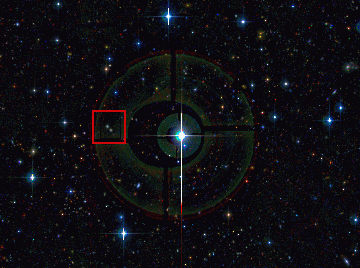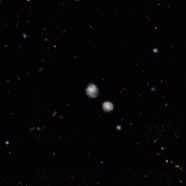Supernovas Shed Light on Dark Energy
Astronomers have new evidence that something called dark energy is revving up the expansion of the universe.
By Emily Sohn
It’s mysterious. It’s so dark that it’s invisible. And, boy, is it repulsive! Still, astronomers who study dark energy in the universe keep learning new things about it.
 |
|
Astronomers examined 71 supernovas to shed new light on dark energy. Here, the supernova is the right-hand white spot inside the box to the left of the central bright star. |
| Julien Guy, CFHTLS/SNLS/Terapix |
Scientists came up with the bizarre concept of dark energy 8 years ago to explain mysterious data that they were collecting from outer space. The data appeared to show that, about 6 billion years ago, something began pushing everything in the universe farther and farther apart at an ever-faster rate.
Scientists called this something “dark energy” and suggested that it supplies a repulsive force that causes the universe to expand outward with increasing speed. Most experts now agree that dark energy exists, but they still have a lot to learn about it.
To find out more, an international team looked at images taken by the Canada-France-Hawaii Telescope on top of Hawaii’s Mauna Kea. The astronomers identified 71 supernovas of a certain type known as “1a.” These are very old stars that explode when they die. We see the light that they emit a few billion years later.
Looking at type 1a supernovas is a good way to learn about the expansion of the universe because the explosions are all roughly equal in brightness at the source, just as all 100-watt light bulbs are equally bright. The farther away they are, though, the dimmer they look. So scientists can look at the brightness of supernovas and figure out how far away they are from Earth.
 |
|
Astronomers examined light from a supernova (right-hand spot of the pair in the middle) to learn more about dark energy. |
| Julien Guy, CFHTLS/SNLS/Terapix |
Also, each supernova gives off a spectrum, or combination of wavelengths, of light. This spectrum shows how quickly the star’s galaxy was moving away when the star exploded.
Using all of this information, the researchers were able to figure out how long ago each of the 71 supernovas exploded. They were also able to estimate the speed of expansion at different times in the history of the universe.
Their analyses suggest that dark energy is spread equally throughout space and time, the scientists say. The findings also help validate what Albert Einstein called a “cosmological constant.” The famous scientist came up with the idea when he proposed a theory of gravitation in 1917, but he quickly retracted the part about the cosmological constant. It just seemed too weird at the time.
Weird, but true. Astronomers plan to continue studying supernovas that exploded at various times. The more they do, the closer they’ll get to understanding what dark energy is all about.—E. Sohn
Going Deeper:
Cowen, Ron. 2005. Cosmic expansion: Supernovas shed light on dark energy. Science News 168(Dec. 17):390-391. Available at http://www.sciencenews.org/articles/20051217/fob6.asp .
Additional information about dark energy and supernovas can be found at www.pparc.ac.uk/Nw/SNLS_dark_energy.asp (Particle Physics and Astronomy Research Council) and www.news.utoronto.ca/bin6/051122-1839.asp (University of Toronto).
Sohn, Emily. 2004. Strange universe: The stuff of darkness. Science News for Kids (Feb. 11). Available at http://www.sciencenewsforkids.org/articles/20040211/Feature1.asp .
______. 2003. Phantom energy and the big rip. Science News for Kids (March 12). Available at http://www.sciencenewsforkids.org/articles/20030312/Note3.asp .







